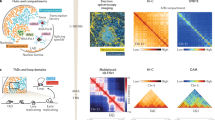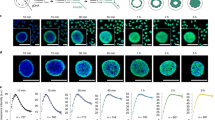Abstract
Price, Conover and Hirschhorn1 have reported the in situ hybridization of haemoglobin mRNA to diploid chromosomes. We think such a conclusion to be impossible because the specific activity of their mRNA was 6 × 10−7 disintegrations per mRNA molecule during the two week exposure of their autoradiographs. As a genome has been reported to contain less than five haemoglobin cistrons2, even if hybridization and autoradiographic efficiencies were 100%, then at most only 6 × 10−6 silver grains would have been produced over the diploid cell's haemoglobin loci.
This is a preview of subscription content, access via your institution
Access options
Subscribe to this journal
Receive 51 print issues and online access
$199.00 per year
only $3.90 per issue
Buy this article
- Purchase on Springer Link
- Instant access to full article PDF
Prices may be subject to local taxes which are calculated during checkout
Similar content being viewed by others
References
Price, P. M., Conover, J. H., and Hirschhorn, K., Nature, 237, 340 (1972).
Bishop, J. O., Pemberton, R., and Baglioni, C., Nature New Biology, 235, 231 (1972).
Wimber, D., and Steffensen, D. M., Science, 179, 639 (1970).
Author information
Authors and Affiliations
Rights and permissions
About this article
Cite this article
PRENSKY, W., HOLMQUIST, G. Chromosomal Localization of Human Haemoglobin Structural Genes: Techniques Queried. Nature 241, 44–45 (1973). https://doi.org/10.1038/241044a0
Received:
Issue Date:
DOI: https://doi.org/10.1038/241044a0
This article is cited by
-
High prevalence of adeno-associated virus (AAV) type 2 rep DNA in cervical materials: AAV may be sexually transmitted
Virus Genes (1996)
-
Hybrido-cytochemical localization of specific DNA sequences by fluorescence microscopy
The Histochemical Journal (1981)
Comments
By submitting a comment you agree to abide by our Terms and Community Guidelines. If you find something abusive or that does not comply with our terms or guidelines please flag it as inappropriate.



